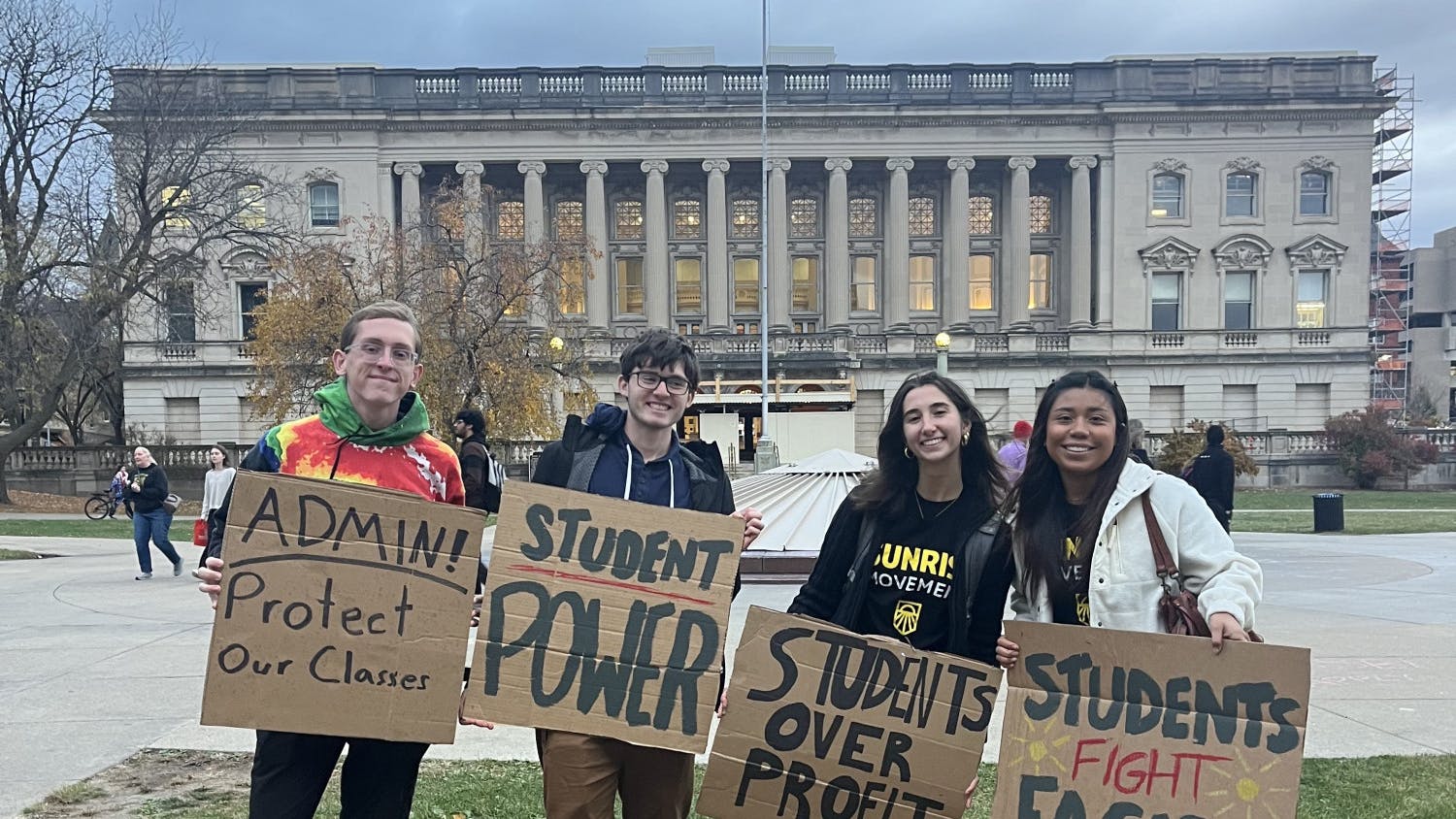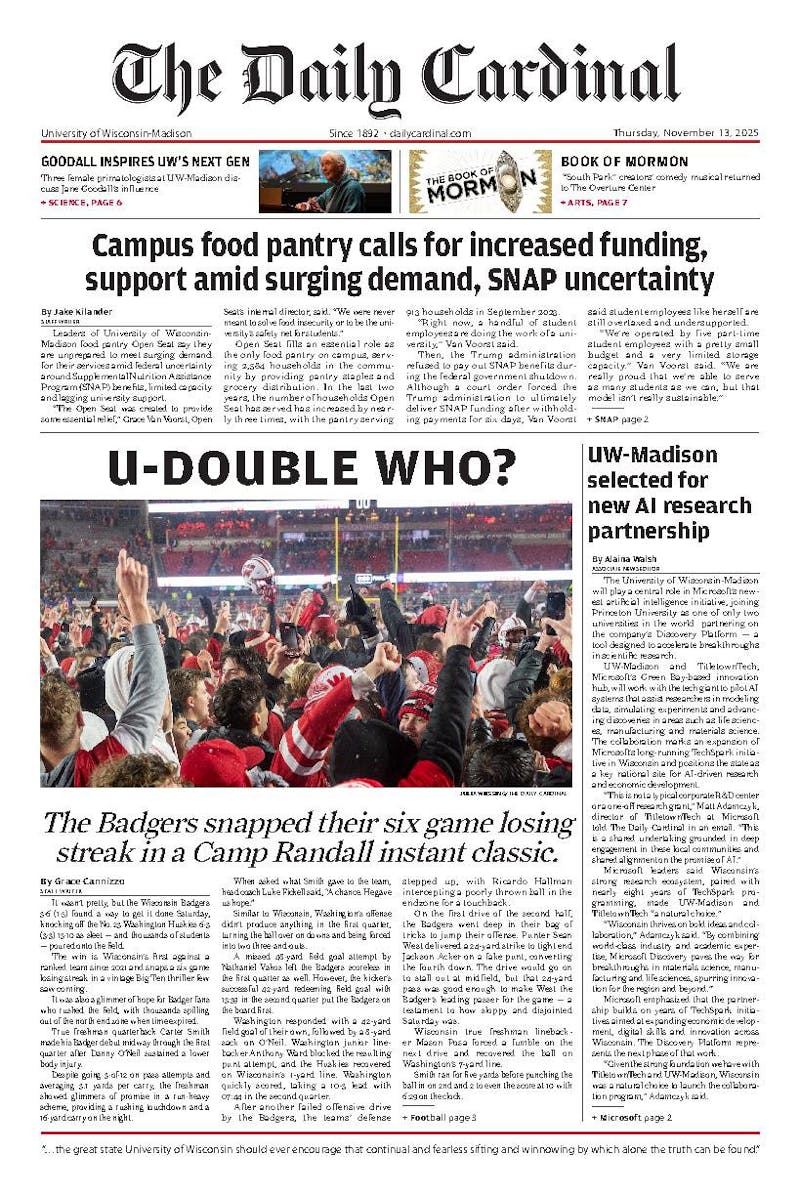It's Saturday night, packed bar, and poetically, from across the room you catch someone's eye. After a short walk and brief introduction, you both sit down and start a long conversation. But even before you hit that stool you have already disclosed much more than you might realize.
The eyes have it
It happens unexpectedly, wreathed in a miasma of cigarette smoke and cheap beer. Eyes meet. Gazing across what seems to be a vast expanse, an entire conversation occurs without the slightest intention and all-too-quickly ends. She looks away, he turns his head.
But, an end to the ocular ballet does not necessarily mean a lack of interest.
According to UW-Madison associate professor Tony Simotes, head of the Undergraduate Acting Specialist Program, 'All these things play out in terms of who is deferring to who.' Meaning, the individual who releases their gaze first is often daring the other to make the first move.
In Simotes' words, when someone looks away, they are essentially making this dare by saying, 'I've committed to you, when I turn my way that's the period.' Then, according to Simotes, it falls to the individual who held their gaze longer to be the pursuer.
'If the person doesn't make that move then [they] might get the one-more-flash look back,' Simotes said. 'And if they don't reconnect, it's like 'okay we're done.''
However, some UW-Madison students also have their own set of criteria for evaluating the situation.
For UW-Madison junior Emily Davenport, the way in which someone looks away in a situation like this can also be an indicator of intentions.
'It depends where they look,' she said. 'If they look down, that's fine, but if they look around that means they're bored.'
Walk this way
Chugging a beer, hoping to find courage resting on the bottom, you spot that pair of eyes drawing nearer. Whether it's a guy whose chest is facing the ceiling, or a girl whose chin is contemplating the floorboards, someone's walk can describe what type of person you're about to deal with.
'People are always either leading or hiding what they feel is their best or their worst attributes,' Simotes said.
If someone wants you to notice something particular, that person will lead with it. Yet, that person will also hide their perceived imperfections that they do not want to reveal immediately.
In the example above, for instance, the male is more than likely proud of his pectorals, while the female may have issue with a facial feature of hers.
I wanna hold your hand
Feeling fey, minds clouded with heavenly ether and spurred by only a momentary glance, two lovers careen toward each other, engaging in a single immortal kiss.
Or, for the rest of us who do not always have the good fortune of being star-crossed, our first meetings will often begin with a handshake. And, although it can be seen as impersonal to some, Simotes believes a simple handshake can convey a lifetime of information about a person without a single utterance.
'With just that one gesture, it sets off a whole list in a person's mind of who this person is,' Simotes said. 'It reminds them of somebody else ?? it just starts flicking off, like a checklist almost, of past experience that starts to categorize who this person is, even if you are only meeting them for the very first time.'
As far as thoughts on the appropriate grip, it varies by student. Xia Lee, a UW-Madison sophomore, said he prefers women who have a looser grip.
'It says that she is shy and is still afraid of talking and touching you,' he said, 'and if her grip is too strong, then it means that she doesn't like you.'
Davenport, however, believes in a stronger, matching grip when she shakes someone's hand for the first time. She does add one caveat, though.
'Don't try to out-firm [someone] because then you're just kind of being an asshole.'
Say anything
Yet, no matter how expressive your eyes, how great your stance, how loving your grip, you are going to have to open your mouth eventually.
For those who are not the 'Fonzies' of their respected social cliques (hint: using the term 'Fonzie' is generally not considered cool), the good news is that it might be less what you say that's important and more so how you say it.
'Either you like the sound or you don't like the sound,' Simotes said of individual preferences for the tone, pitch and volume of certain voices.
'Sometimes you can be really attracted to somebody,' he said, but 'then you hear them speak and the sound is so nasally or squeaky there's just something about it you can't get through because on some level, when you hear it, it is a kind of remembering of something that's unpleasant.'
Using the right tone of voice in a certain situation can be critical, he said.
Men tend to use quieter, lower tones when speaking, and the decrease in volume can be a subconscious attempt to bring the other person closer.
'It's very true that pitch and tone of the voice definitely make a difference,' Simotes said. 'Someone might speak softly so that [others] are drawn in to be able to hear.'
The lower vocal tones, which Simotes described as 'stirring the lower sounds,' emanate from deep inside and send out a certain 'rhythm.' When someone talks in these lower tones that person is sending out that rhythm to see if the other person connects with it.
'It's a lower guttural sound that on some deeper level imitates the tones of what love making could be,' Simotes said.
Many female students, however, feel they tend to use higher tones. Shannon Higgins, a sophomore at UW-Madison, believes there is a reason she uses higher than normal tones when first meeting a guy.
'Lower pitches are generally the more dominant,' Higgins said. 'But if a girl's trying to be flirty with a guy, she wants him to be the dominant one.'
According to Simotes, using these higher tones is generally a person's effort to sound younger or more whimsical.
'[People use higher tones] to be seen as either more boyish or more giggly, as a younger girl,' he said, 'if they believe that on some level that's attractive and the other person would see that as attractive.'
I've got rhythm
As your new love interest takes a seat next to you and strikes up a conversation, non-verbal expression will continue unabated.
According to Simotes, rhythm can be another important form of nonverbal communication in a first meeting, as two parties continue to try and get a better feel for each other.
'Say they're sitting on a chair that swivels,' Simotes said, using a bar setting as an example. 'Are [two people] moving and engaging in a kind of rhythmic activity? That rhythm suggests 'do you have a like rhythm with me'? It could imitate dancing, can obviously on a deeper level imitate 'would this person be fun to play with physically''?
In conclusion...
Now, as fair warning, none of these physical cues should be taken as constants. Though they hold true in many situations, every person is different and there will always be many exceptions to the general rules.
'Men and women do have their own kind of language,' Simotes said. However, 'it's not a blanket or a generalization.'
Still, he stresses the importance of the cognizance of our bodies in any given situation.
'I think that it's a language that we all need to be aware of because these physical lines of dialogue are there to be interpreted, used.' he said. 'Sometimes, in life, language itself is not the best way to communicate because of its complexity, and physical language can be a more accurate way to express exactly what's in someone's heart or on their mind.'





